Clarification of The Possibilities of Pinot Noir in Burgundy. Domaine du Pavillon Articulates The Case Throughout Côte de Beaune’s Appellations with Vintage 2020
So well does Pinot Noir align with its terroir that it is no stretch to claim that the Burgundian earth itself was mute before the first plantings. But the truth is, fickle Pinot Noir has found its spiritual home here only through centuries of trial, error and site selection along with the endless pruning required to allow the grape its most expressive stage. In truth, there are many grapes that are easier to grow in Burgundy, are subject to fewer diseases, are easier to maintain and which produce a more consistent and copious yield. The problem? They aren’t Pinot Noir.
Domaine du Pavillon, one of the Albert Bichot constellations of excellent estates, has produced a variety of Côte de Beaune Pinot-based wines that articulate not only the heritage that has permitted this red wine grape to maintain a crowning place in the varietal hierarchy for centuries, but points to the stylistic changes that might be inevitable as part of the future new normal.
Throughout Burgundy, grapes have been regularly gaining ripeness and palate-sweetness unheard of even 20 years ago, while green, unpleasant tannins that refuse to soften or ripen with age are nearly a thing of the past. For all the horror stories (and none should be downplayed, of course) climate change has had an odd effect in Burgundy. Contemporary wines may be more seductive and charming when young, but are also likely to age well, as these outstanding selections for Domaine du Pavillon prove.
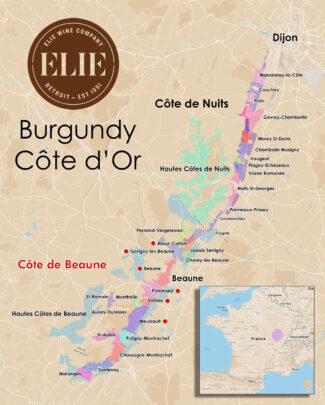
Burgundy: Land of Climats
Nowhere has an obsession with the minutia that connects wine to earth been pushed as far (and in such an elaborate manner) as in Burgundy. And nobody else has coined a term that more adequately describes this compartmentalized vineyard structure: ‘Climat.’ Carefully defined for centuries, and having remained virtually unchanged to the current day, a ‘climat’ is a parcel of vines which has its own name, its own history, its unique taste and place in the lexicon of wines. More than a thousand of them are inscribed on the UNESCO World Heritage List.
This is not to give a lower profile to the hundreds of communes and villages throughout Burgundy that also place a premium on self-expression. One of the great joys of the Burgundian experience is to explore each appellation and learn to distinguish identifying characteristics, from the most broad to the most nuanced.
Pinotism Reigns
For all the drawbacks inherent in the work-intensive, thin-skinned, low-yielding Pinot Noir variety, the end result is a wine that announces its place of origin louder than nearly any other. When coddled and protected, Pinot responds by mirroring the subsoil in which it is rooted, the slope of the land as it drains and the absorption of sunlight—in short, its microclimate. Referred to as ‘an infinite sensory experience’, Pinot Noir offers a wide variety of aromas when young, from fresh berries to spicy pepper and cinnamon, often underscored with coffee and smoky notes. Over time, the fresh fruit flavors will transform into mature notes of jam or kirsch, and the wine will develop exquisite aromas of wild mushroom or truffle accompanied by feral notes like leather or fur.
As an interesting historical side note, following the Black Plague (1349) many neglected Pinot vineyards were replanted to Gamay, which was not only more disease resistant, but produced more wine. The re-crowning of Pinot did not happen for more than a century (and over the objections of wine merchants who preferred the easy profits generated by copious and inexpensive Gamay); it required edicts from noblemen, including Duke Philippe le Hardi, who declared that Gamay was ‘most harmful to every human creature to such an extent that those who use it are subject to serious illnesses.’
Vintage 2020: Voluptuous and Structured
François Labet, a négociant whose family has lived in Beaune for 300 years, summarizes the 2020 vintage like this: “An intellectually-challenging vintage; the reds in particular defy easy categorization because the impact of that season varied considerably by terroir. Producers had key decisions to make, especially when to pick and that significantly affected both the style and quality of the resulting wines.
And this is because the most notable feature of this vintage was its early and rapid harvest: Many domains began picking the week of August 17th and while August harvests have been frequent in the 21st century (there were none in the prior century), this was for many domains the first time they had not only started, but completed a harvest before the end of August.
The resulting wines (particularly from earlier harvests where sugars were high and acids intact) are remarkable, both for whites and reds. The season was hot and dry, but water tables were healthy from the mild and wet preceding winter.
Beaune was particularly fortunate and Chef de Cave Frédéric Weber (Bouchard Père et Fils) describes 2020 as a concentrated and strong vintage: “It reminds me of 2016 for its vibrancy and energy; the wines are voluptuous and structured. A great vintage for the future, like the ‘18s.”
Vintage 2019: Concentrated and Vibrant
Of the bullseye vintage of 2019, Dimitri Bazas of Maison Champy in Beaune, says, “If you offer me a contract for 30 years and it promises that every year will be like 2019, I will say, where do I sign?”
In the season before the pandemic, a new phenomenon was beginning to take hold in Burgundy and growers were baffled: The 2019 vintage, largely from a drought year, showed previously unseen levels of both ripeness and acidity, producing a baffling combination of searing freshness, perfect ripeness and crystalline purity. After a blustery February and a wet March, well-forecasted frost hit in April, but after that, things heated up and stayed blisteringly hot through the beginning of September, when it cooled down and allowed the grapes on the vine to maintain good acids.
Côte de Beaune’s Benjamin Leroux maintains, “2019 is a great vintage, with quality to be found across the region and at every level. There are, naturally, different styles of wine, and some growers and areas have been more successful than others, but there should be something to appeal to all budgets and palates. In an uncertain world, the ’19 vintage offers reassurance: you can buy it with confidence.”
Domaine du Pavillon
The Essence of Côte de Beaune
Located south of Pommard, the Côte de Beaune’s Domaine du Pavillon is under the vinous umbrella of the Bichot family, who settled in Burgundy in 1350. Albéric Bichot took over management in 1996, and although he fully respects traditions, he remains focused on the future, comparing himself to the ‘conductor of an orchestra, proud to bring people and their talents together over a common project.’
Among those common projects is Domaine du Pavillon, whose 37 acres of vines include just under ten acres of Bichot’s Pommard monopole ‘Clos des Ursulines’.
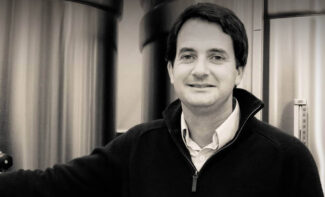
Matthieu Mangenot
Meanwhile, among the talented people he has brought together is head winemaker Matthieu Mangenot who brings to Beaune a wealth of experience from estates in South Africa, Lebanon and Bordeaux. After his first experience in the Mâconnais/Beaujolais region, he joined Albert Bichot in 2007 as manager of Domaine Long-Depaquit in Chablis. His dual training as an agronomist and an oenologist allows him a comprehensive approach to winemaking, from vineyard management to bottling. His knowledge of soil formations and his pragmatic, transversal approach benefit the development of the House’s productions and pair well with its concern for authenticity and sustainability. “The wines of the Pavillon will bear the certified ‘organic wine’ label starting with vintage 2018,” he promises.
Viticulture is handled by Christophe Chauvel, assisted by Dominique Bon. Chauvel arrived in Burgundy in 1982 to study at Beaune’s viticultural secondary school, and after gaining experience under Sommelier Jean-Luc Pouteau at the restaurant Pavillon Elysée Lenôtre in Paris, he decided to go back to school to follow a 4-year winemaking program in Bordeaux. He joined the Albert Bichot estates in 1999.

Christophe Chauvel, left, Dominique Bon, right
Dominique Bon became interested in viticulture as a young boy. After 3 years of studies at Beaune’s viticultural secondary school, he was made manager at an estate in Meursault, in charge of clients’ vines (and vinification) for 13 years. On the side, he took over a small, six-acre estate which he still looks after. He joined Albert Bichot in 2000 as vineyard manager at Domaine du Pavillon where his knowledge of vines and specificities of the local terroirs are precious assets.
Work In The Vineyard
The twin motivators of respect for nature and respect for the planet are the cornerstone of Domaine du Pavillon’s approach to the craft. Sustainable viticulture is the watchword, based on observation, prevention and paying attention to the complex balances found in nature. Pavillon soil is maintained responsibly, judiciously ploughed and fertilized using only organic matter. In the field, hands-on labor boosts the plants’ natural defenses and dedicated teams know every nuance of the terroir perfectly and remain attentive to the development of the vines as they grow.
At The Winery and In The Cellar
‘As little intervention as possible’ animates Pavillon’s vinification process in each of Burgundy’s major viticultural regions from which they pull their grapes. The wines are always transferred from vinification vats or barrels to the cellars by gravity—the gentlest, most earth-friendly method. There it is allowed to mature in casks for 12 to 18 months in barrels, some new, some used. It is during this key period, when time and expertise come together, that wines first begin to reveal their personality and hint at their potential. Depending on the vintage, combinations of oak from different origins (Tronçais, Allier, etc.) and of varying degrees of toast are used to impart discrete yet complex nuance to the finished product.
Meursault
There’s a rumor that Meursault’s name (derived from the Roman ‘muris saltus’, or mouse-leap) is meant to measure the distance between Pinot Noir acres and Chardonnay acres within the appellation. Alas, it’s an apocryphal tale—it actually refers to the Ruisseau des Cloux stream, which the centurions were able to easily get across.
Sitting at the entrance to the Saint-Romain valley—a gap in the Côte d’Or—the commune of Meursault stretches for three miles from north to south, making it about twice as large as Puligny. Most of the vineyards are located on the slopes of the Côte d’Or escarpment and are blessed with classic Burgundian limestone and marl soils. The vines are planted in a variety of orientations in the local hillsides, due south through due east, and such differences become one of many contributing factor to the variation of styles in Meursault wines.
Meursault contains 714 acres of Village-level vineyards and 259 acres of Premier Cru sites; more than 200,000 cases of white wine are produced per year, plus around 4000 cases of red wine.
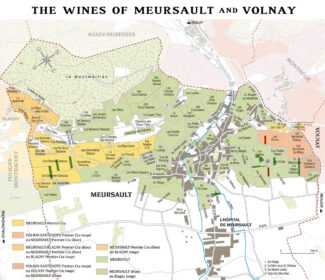
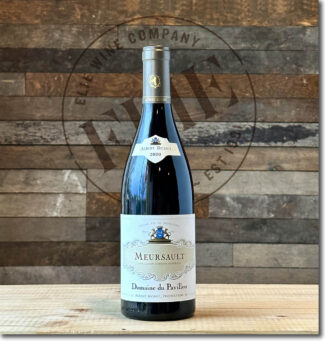 Domaine du Pavillon, 2020 Meursault ($55) Red
Domaine du Pavillon, 2020 Meursault ($55) Red
From a 0.8 acre site of 40 year old vines located just north of the village of Meursault, where exposure is east/southeast and the soil is marly clay. Hand-picked, the Pinot Noir is crushed, then put in temperature-controlled conical oak vats for four weeks and aged in oak for 14 -16 months, 20% new. The wine displays a delicate nose of crushed cherries and rose petals with a touch of coffee and elegant tannins on the finish. 2000 bottles made.
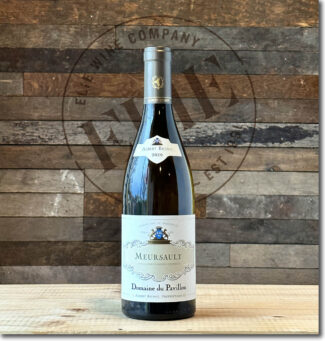 Domaine du Pavillon, 2020 Meursault ($99) White
Domaine du Pavillon, 2020 Meursault ($99) White
Drawn from 5 plots totaling 5.6 acres of 30-year-old vines grown on white marly limestone and clay. The wine is vatted in 30% new oak, then aged in oak for another 12 – 15 months. It reveals a nose of yellow peach, vanilla and toasted almond, round in the mouth with elegance and length and a crisp, mineral finish. 15,000 bottles made.
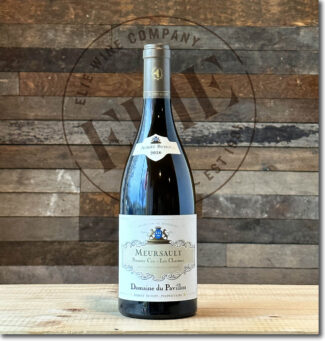 Domaine du Pavillon, 2020 Meursault Premier Cru Les Charmes ($153) White
Domaine du Pavillon, 2020 Meursault Premier Cru Les Charmes ($153) White
From a 2.89 acre plot, mostly from the upper portion of the Les Charmes lieu-dit called ‘Charmes du Dessus.’ Exposure is east/southeast on gentle slope at an average elevation of 800 feet. The soil is calcareous clay and the vines are around thirty years old. The juice is vatted in oak, about 60% new, then aged in oak for about 15 months, 25% new. The wine features aromas of candied lemon, toasted almond, white flowers and freshly baked bread; palate is smooth and velvety without heaviness and mirrors the bouquet’s aromas. 7,500 bottles made.
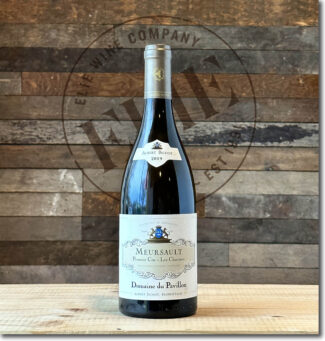 Domaine du Pavillon, 2019 Meursault Premier Cru Les Charmes ($153) White
Domaine du Pavillon, 2019 Meursault Premier Cru Les Charmes ($153) White
Les Charmes is among a cluster of top climats, with Genevrières on the northern border and Perrières above it on the slopes. Charmes Premier Cru wines tend to be vibrant and honeyed with rich, nutty characters and floral overtones. A large and diverse area, this particular cuvée is a blend of primarily Dessus (the upper part of the vineyard) and a lesser amount of the lower portion, called Dessous. The wine is laced with peach, lemon cake and sweet spice aromas along with acacia and spice and bright acidity adding lift. 7,500 bottles made.
Volnay
No red wine appellation is more synonymous with ‘perfume’ than Volnay; the wines have historically checked all the boxes for quality, vigor and longevity but with an aromatic delicacy traditionally referred to as ‘feminine.’ The appellation has existed since 1937, and is reserved for Pinot Noir-based red wines exclusively. Although the region contains no Grand Crus, more than half of the vineyards covered by Volnay’s 526 acres are rated as Volnay Premier Crus. Just across the boundary that delimits Meursault, Volnay-Santenots is grown on terroir better suited to Pinot Noir than Meursault’s legendary Chardonnay.
The appellation stretches across a narrow band of oolitic limestone on the hill of Chaignot, with vineyards facing south-east. At the top of the slope, the soil is pink in color with pale green inclusions overlain by schist. As the ground descends, white, chalky-textured argovien limestone takes over, with a third layer of reddish Bathonien limestone finally giving way to deep gravel soils at the foot of Chaignot.
These varied soils combine to give relatively small Volnay a remarkable number of recognized lieux-dits (24) and climats classified as Premier Cru (34), each unique in expression, but yoked by an inimitable Volnay style: Spicy fragrance, elegant structure and silken mouthfeel, qualities that transcend producers, both of the traditional old guard and the innovative new.
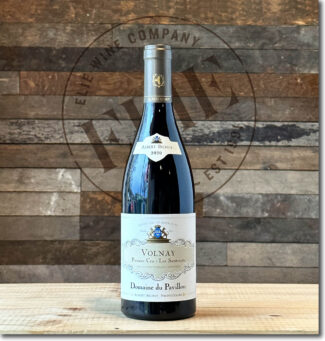 Domaine du Pavillon, 2020 Volnay Premier Cru Les Santenots ($99) Red
Domaine du Pavillon, 2020 Volnay Premier Cru Les Santenots ($99) Red
‘Les Santenots’, a Volnay Premier Cru, is actually located in Meursault, just to the south of Volnay. Though best known for its white wines, certain Meursault terroirs (such as Les Santenots) are better adapted to bringing out the finesse of Pinot Noir rather than Chardonnay. From a 0.7-acre climat, the soil is brown calcareous clay, the vines are 30 – 40 years old and vatting is done in temperature-controlled conical oak vats for 20 to 28 days, then aged in 35% new oak. The wine encapsulates the elegance and purity for which Les Santenots is known; aromas of red currant, dried rose petals and cinnamon with silken tannins and a chewy finish. 1500 bottles made.
Pommard
If Burgundy is a volume of poetry, Pommard might be thought of as its Alfred, Lord Tennyson, offering power and rich structure, a charge of the Light Brigade, only with a substantially safer outcome. Pommard is the beginning of serious Pinot Noir in Burgundy; nothing else is grown and nothing else allowed besides (perhaps inexplicably) a few vineyards of the Lemberger/ Sankt-Laurent cross ‘André.’ Aptly named for Pomona, the Roman god of fruit trees, Pommard’s most muscular wines hail from its mid-slope Premier Cru vineyards which run in a nearly uninterrupted from the commune boundaries of Beaune in the north to Volnay in the south. Even that may belie the quality of these wines; most experts believe that the Les Epenotes and Les Rugiens Premier Crus should be promoted to join Corton in its Grand Cru status. Once in line for this prestigious upgrade, the vignerons of the time were wary of the restrictive Grand Cru production laws and declined the offer.
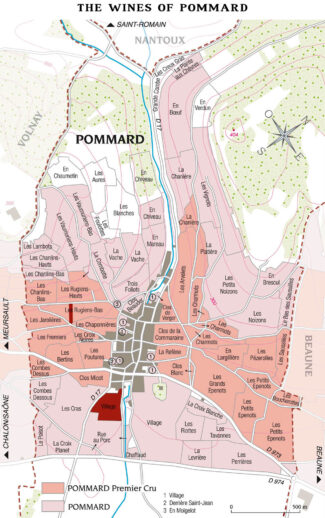
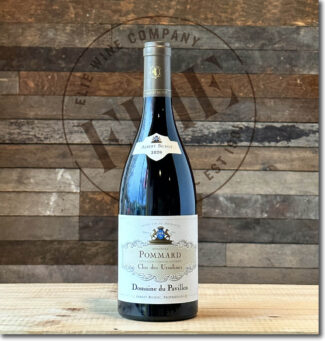 Domaine du Pavillon, 2020 Pommard ‘Clos des Ursulines’ Monopole ($77) Red
Domaine du Pavillon, 2020 Pommard ‘Clos des Ursulines’ Monopole ($77) Red
‘Clos des Ursulines’ is a peaceful haven dotted with centuries-old pine trees and named for the Ursuline nuns that were the first owners of the estate. The ten-acre vineyard is now owned entirely by the domain—hence, the designation ‘monopole.’ It at the southern end of the Pommard appellation, toward Volnay, where the soil consists of calcareous clay with white marls; the vines are 40 years old. After spending four weeks in conical oak vats, the wine is aged on oak for another 16 months and showcases the rich fruit of Pommard; black cherry, cassis and fig. Given time, these notes will evolve toward coffee and leather. 18,000 bottles made.
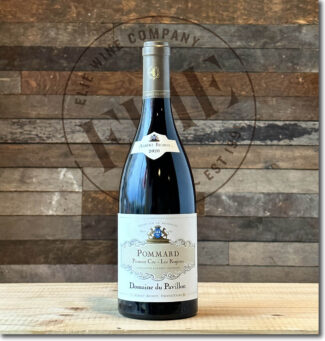 Domaine du Pavillon, 2020 Pommard Premier Cru Les Rugiens ($169) Red
Domaine du Pavillon, 2020 Pommard Premier Cru Les Rugiens ($169) Red
Rugiens is one of Pommard’s most highly-prized vineyards, considered by many to be worthy of Grand Cru status. The wines are full-bodied and brooding with smoky, spicy aromas capable of improving for many years. Pavillon’s offering is from an 0.8-acre parcel just south of Pommard, in the Rugiens Bas, or lower slope where the soils are brown/red clay containing hard limestone. The wine shows great energy and precision with virile, concentrated notes of cherry compote and raspberry syrup that evolve into pepper, licorice and eucalyptus behind soft, integrated tannins. 1600 bottles made.
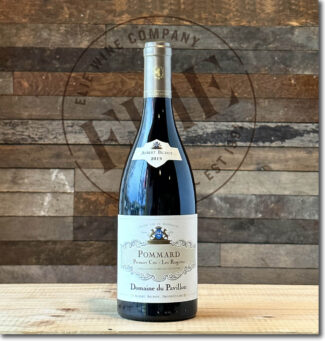 Domaine du Pavillon, 2019 Pommard Premier Cru Les Rugiens ($171) Red
Domaine du Pavillon, 2019 Pommard Premier Cru Les Rugiens ($171) Red
The muscular structure of Rugiens wine is often attributed to the rich iron content of the soil, evident in its reddish color which also lends the climat its name. This rocky, calcareous soil covers hard limestone bedrock and provides good drainage, so vines have to work hard to find nutrients and hydration; this helps to curb both vigor and yield. Small, high-quality berries make concentrated wines: Here, the juice is allowed to ferment for up to 28 days, then is aged in 30% new oak barrels for 18 months. The wine’s brilliant, high-toned bouquet of black fruits and herb-rubbed grilled meat display earthiness beneath a compact ultra-ripe core. The silky texture continues through the finish. 1600 bottles made.
Beaune
The historical capital of Burgundy, Beaune eponymous appellation includes 42 Premier Cru Climats producing primarily red wine (887 acres of Pinot to Chardonnay’s 143. Village-level wines can be somewhat homogeneous, although from the northern end of the commune they tend to be intense while those from the southern end are smoother and fuller.
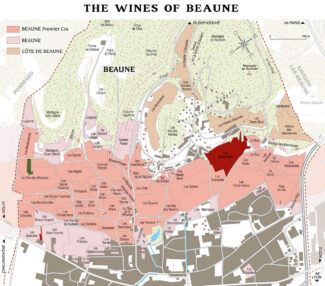
Beaune’s slopes are quite steep and the soil is thin; a breakdown of the terroir is a mouthful and a half: On the lower slopes are Argovian marls and deep soils, white, grey or yellow, tinged with red from the iron in the Oxfordian limestone. Exposures are easterly to due south at altitudes between 700 and a thousand feet.
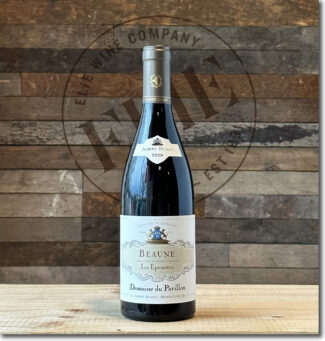 Domaine du Pavillon, 2020 Beaune ‘Les Epenottes’ ($55) Red
Domaine du Pavillon, 2020 Beaune ‘Les Epenottes’ ($55) Red
Epenottes lies in the southern part of the appellation, on the edge of Pommard. It is terroir is similar in to Pommard, but the wines have a more delicate touch, with finer structure and subtle silkiness. The vineyard name is derived from the word ‘épine’ for thorn, and designates a place where a variety of thorny trees, shrubs and bushes once grew. From a 1.5 acre southeast-facing site, the wine shows candied cherry, blackberry and cassis with toasted hazelnuts and chocolate. The palate is generous and structured and finishes with notes of violet and licorice. 3600 bottles made.
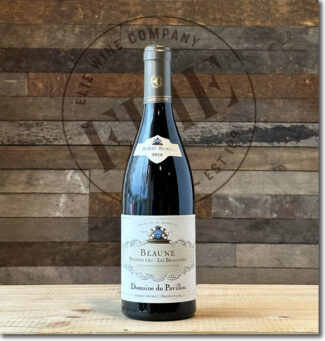 Domaine du Pavillon, 2020 Beaune Premier Cru Les Bressandes ($83) Red
Domaine du Pavillon, 2020 Beaune Premier Cru Les Bressandes ($83) Red
Among the best-known climats of Beaune is ‘Les Bressandes’, located a quarter mile from Aloxe-Corton. The property’s northeast end borders the commune of Ladoix-Serrigny and, by its shallow, rocky clay-limestone soil, is able emphasizes the most elegant turn of Pinot Noir’s profile, at times imparting a unique chalky character. Like Epenottes, the vineyard gets its name from the flora—the bresse, or brush—which grew here before grapes. The vines are between 30 and 40 years old, grown on clay-limestone soil with a relatively sandy texture. The wine is high-toned with bright pomegranate flecked with mineral and saline notes. Tannins are powdery and the finish mineral-filled.
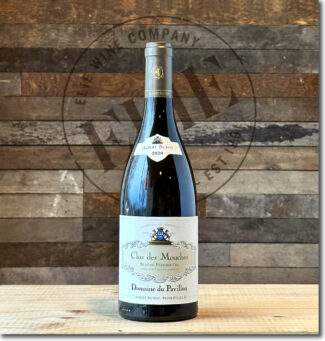 Domaine du Pavillon, 2020 Beaune Premier Cru Clos des Mouches ($153) White
Domaine du Pavillon, 2020 Beaune Premier Cru Clos des Mouches ($153) White
Le Clos des Mouches is one of Beaune’s most highly respected Premier Cru vineyards, planted to both Chardonnay and Pinot Noir. Several of Burgundy’s top domains and négociants own parcels within the 60-acre property, although Drouhin owns more than half. Pavillon owns a bit more than an acre in the upper part of the clos, where altitudes are more than nine hundred feet on marly limestone. The wine was vatted for two months and then placed in oak for 12-115 months. The wine shows a complex floral nose—white lilac and white rose—leading to fruit aromas, especially green apple and mango which evolves towards hazelnut and almond. Allowed to mature, the wine will show and elegant mesh of white truffle, citron, honey and nutmeg. 4900 bottles made.
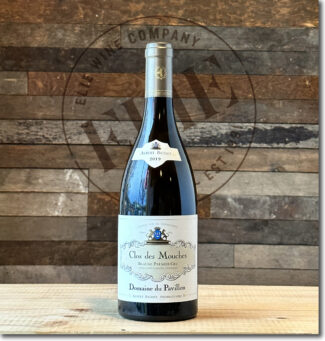 Domaine du Pavillon, 2019 Beaune Premier Cru Clos des Mouches ($171) White
Domaine du Pavillon, 2019 Beaune Premier Cru Clos des Mouches ($171) White
Des Mouches sits at the very southern end of the commune, at the boundary with neighboring Pommard. The equally well-regarded Les Montrevenots vineyard lies above and to the northwest. The clos sits mid-slope of the Montagne-Saint-Desire hill facing southeast, exposing its vines to direct sunshine throughout the morning and into the afternoon, an aspect that allows it to dodge the hotter, harsher sunshine of later afternoon, and permits the grapes to ripen slowly and steadily throughout the growing season. An extra year of aging has imbued this wine with cooked apple and lemon-curd aromas around a buttery mid-palate that also shows hints of lychee, jasmine tea and tangerine peel.
Savigny-lès-Beaune
Chances are, you love wines from the Rhine and are passionate about wines from the Rhône, but at first glance, ‘wines of the Rhoin’ may look like a typo. In fact, this small river flows from the cliffs of Bouilland through the commune of Savigny-lès-Beaune, and alluvia from the overflow adds fertility to the lower slopes of the hills of Beaune. With nearly nine hundred acres of vineyard, the appellation is one of Burgundy’s largest.
Savigny’s terroir features a gentle gradient that becomes steeper as the altitudes approach 1300 feet, where the geology is similar to that of the great Grand Cru hill of Corton. Favored exposures face the south, where the soils are gravelly and scattered with oolitic ironstone. Near the river valley, the red-brown limestone becomes more clayey and pebbly, while the east-facing slopes consist of sand and limestone.
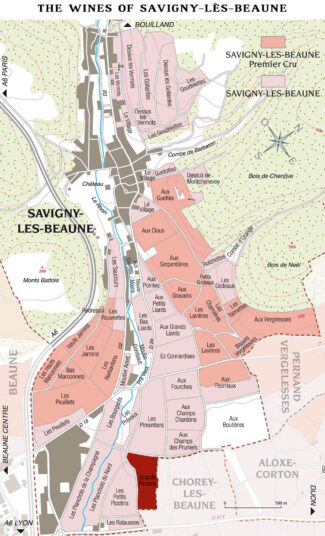
As rich in history as it is in Premier Cru vineyards (there are 22), Savigny-lès-Beaune was once a social hub where the nobility and clergy rubbed shoulders, and the near mythical regard for the quality of its wine is reflected in a stone carving on a Savigny château: “The wines of Savigny are nourishing, theological and keep death at bay.”
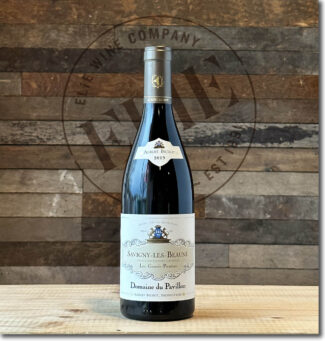 Domaine du Pavillon, 2019 Savigny-lès-Beaune ‘Les Grands Picotins’ ($58) Red
Domaine du Pavillon, 2019 Savigny-lès-Beaune ‘Les Grands Picotins’ ($58) Red
In the patois of the time, ‘faire leurs picotins’ was a parcel used by horses to rest and sleep. The terroir, according to Pavillon, is strongly influenced by the combes (valleys) of Savigny-lès-Beaune and Pernand-Vergelesses. The soils are gravel and calcareous clay; the wine is fermented for 25 days and aged in oak, 20% new, for 12 – 15 months. It shows a perfumed bouquet reminiscent of rose petals with hints of cranberry and bergamot; the medium-bodied palate displays tart red cherries, crushed strawberry and light orange zest with acidity lending bite at the finish.
Aloxe-Corton
The appellation of Aloxe-Corton stands guard near vinous gates of the Grand Crus of Corton and Corton-Charlemagne, enjoying (if not the prestige) many similar growing conditions, producing almost exclusively red wines known for both a depth of color and an intensity of flavor. With vines facing east, the terroir is soil driven, with flint and limestone rich in potassium and phosphoric acid lending supple firmness to the wines, especially those from the appellation’s southern end.
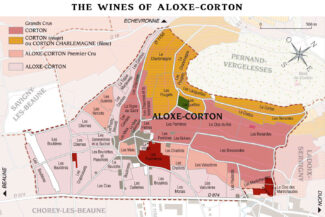
Whereas white wines from the region exist, they are rare. The deep soils are better suited for Pinot Noir; the terroir is a geological cradle for this prima donna varietal. At altitudes averaging 800, the vineyards are planted in reddish earth with flint and limestone debris known locally as ‘chaillots’ mixed in, and likewise rich in potassium and phosphoric acid. Such soils favor supple, highly-bred wines, while clay and marl breeds firmness and complexity. Anticipate wild berry notes that intensify with age and evolve into peony and jasmine, brandied fruits, pistachio, prune and truffle.
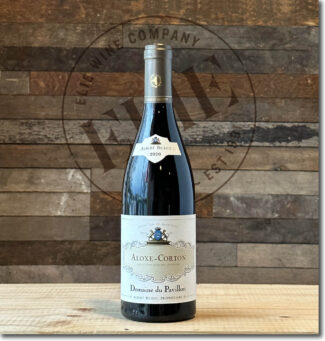 Domaine du Pavillon, 2020 Aloxe-Corton ($69) Red
Domaine du Pavillon, 2020 Aloxe-Corton ($69) Red
From the south end of Aloxe-Corton; the unlovely-sounding ‘Crapousuets’ is actually a one-acre lieu-dit that produces deeply serious Pinot Noir: This one shows a dark, ferrous nose with spiced cherry and cassis notes behind sweet damson and ripe, soft tannins. 3000 bottles made
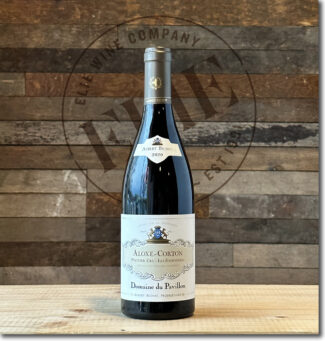 Domaine du Pavillon, 2020 Aloxe-Corton Premier Cru Les Fournières ($93) Red
Domaine du Pavillon, 2020 Aloxe-Corton Premier Cru Les Fournières ($93) Red
From another one-acre plot on the eastern fringe of Aloxe-Corton at the base of the Corton hill, with some vines creeping up the lower slope. These 40-year-old vines are planted on scree overlying limestone. The name comes from the practice of clearing parcels by a burn-out process in stoves where the dried clods of kindling are called ‘fournières.’ The wine offers up a vibrant nose of ripe cherries and quintessential Corton spices with an appropriate touch of bonfire and supple tannins.
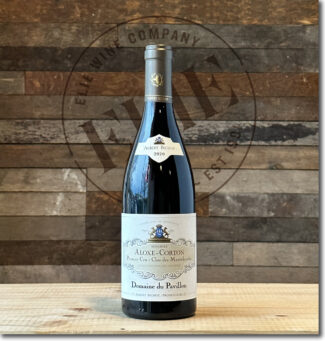 Domaine du Pavillon, 2020 Aloxe-Corton Premier Cru Clos des Maréchaudes Monopole ($93) Red
Domaine du Pavillon, 2020 Aloxe-Corton Premier Cru Clos des Maréchaudes Monopole ($93) Red
Clos des Maréchaudes is a 3.4 acre walled vineyard located on the lower slopes of the Corton hill, only partly in the commune of Aloxe-Corton and straddling the border of Ladoix-Serrigny, owned entirely by Maison Bichot under the Pavillon title. It is but one of multiple designations within the wider Les Maréchaudes vineyard—the top two-thirds of the site have Grand Cru status as ‘Corton Les Maréchaudes.’ Several Premier Cru designations cover the lower third. The wine is an earthy cornucopia of forest berries, loam, kirsch and the supporting structure to reward a decade or more of aging.
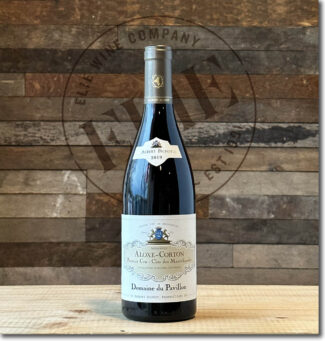 Domaine du Pavillon, 2019 Aloxe-Corton Premier Cru Clos des Maréchaudes Monopole ($103) Red
Domaine du Pavillon, 2019 Aloxe-Corton Premier Cru Clos des Maréchaudes Monopole ($103) Red
Like its illustrious neighbor, the equally-illustrious Corton Grand Cru Monopole, Clos des Maréchaudes belongs to the Domaine du Pavillon estate. The soil here is brown limestone overlying scree with a high proportion of clay. The name is derived from the Old French term ‘maresche’, meaning ‘marsh’—the lower parts of Aloxe-Corton and Ladoix-Serrigny were once wetlands due to their proximity to the Lauve spring and major drainage was required to make the land suitable for viticulture. Dried cherries and cranberry on the nose with understory of rich leather, forest floor, earth and eucalyptus and a long, mineral-focused finish.
Grand Crus in Aloxe-Corton
The hill of Corton lies in the midst of a cluster of famous wine-growing villages—Ladoix-Serrigny, Aloxe-Corton, Pernand-Vergelesses and Savigny-lès-Beaune. ‘Corton’ is the largest Grand Cru vineyard in Burgundy, and one of only two where wines are made from both Pinot Noir and Chardonnay—the other being Musigny. The geomorphology is a main factor in the breathtaking quality of these wines; the vineyards lie at heights of 820 – 1100 feet, forming a geographical amphitheater not found elsewhere in the Côte. Corton Grand Cru received its AOP status in 1937 and only the red wines have the right to add the name of their climat to that of the appellation.
Corton-Charlemagne occupies the highest portion of the Corton hill, where the slopes are steep, with grades up to 23%. The hill itself offers an exemplary geological cross-section through the younger Jurassic strata that lie between Ladoix-Serrigny and Meursault. The color of the clay-rich marly soils varies from yellow to ochre to brown, and limestone alternates with marls beneath a thin cover of rendzinas—humus-rich, shallow soil formed from carbonate or sulfate-rich parent material. It is ideal conditions for Chardonnay rather than Pinot Noir, which is why Corton-Charlemagne produces white wine exclusively. At mid-slope the red wines of the Corton appellation grow on soils that are appreciably different in character.
 Domaine du Pavillon, 2020 Corton ‘Clos des Maréchaudes’ Monopole Grand Cru ($169) Red
Domaine du Pavillon, 2020 Corton ‘Clos des Maréchaudes’ Monopole Grand Cru ($169) Red
This wine comes from Domaine du Pavillon monopole with the rare distinction of possessing two different levels of appellation within the same five acre vineyard. The 1.3 acre Grand Cru lieu-dit features the sunniest portion of the vineyard. Wonderfully ripe, with concentrated berry notes along with the feral muscle that Corton develops. Dark, proportionate and dense with stones and smoke alongside cherry jam and anise. 2500 bottles made.
 Domaine du Pavillon, 2019 Corton ‘Clos des Maréchaudes’ Monopole Grand Cru ($189) Red
Domaine du Pavillon, 2019 Corton ‘Clos des Maréchaudes’ Monopole Grand Cru ($189) Red
The Grand Cru portion of the vineyard yields wines of greater concentration than those from the top of the terrace where there is a bit more clay. The appreciable increase in quality is revealed in greater density, better structure, more length and extensive depth to the fruit character. This wine is a poster child for the phenomenon with a drinking window that should last until 2039.
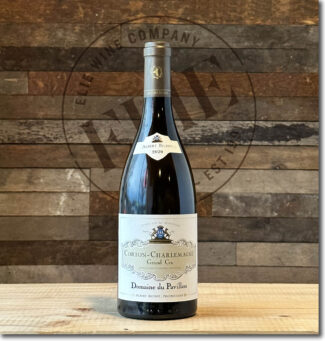 Domaine du Pavillon, 2020 Corton-Charlemagne Grand Cru ($289) White
Domaine du Pavillon, 2020 Corton-Charlemagne Grand Cru ($289) White
Located in the ‘Les Languettes’ climat on the south/southeast side of the Corton hill, the plot once belonged to the nuns of the Lieu-Dieu Abbey and was nicknamed ‘Vigne Dieu’ by the old wine merchants of Aloxe-Corton. The terroir is brown soil overlying Argovian marls and oolitic limestone, perfect for Chardonnay, whose position on the slope is a showcase for finesse, delicacy and purity. The wine presents aromas of hazelnut, verbena and buttery honeyed toast with deep baked-apple savoriness and a solid spine of acidity. 7000 bottles made
Notebook …
Climate Change is Taking Root
In 2023, melting glaciers and persistent droughts are spreading, and not at a glacial pace. All areas of agriculture are being impacted, and far more quickly that science had predicted. For farmers who grow wine grapes, the effects have impacted the soil, the roots of the vines and the yields of crops. For France, this has been particularly devastating—in 2021, France recorded its smallest harvest since 1957 and lost more than $2 billion in sales; a huge blow to the country’s second-largest export industry.
In France overall (and in Burgundy in particular), terroir is the heart and soul of wine expression, and terroir encompasses all the factors that go into producing the grapes, from subsoil to elevation. And climate plays a vital role in terroir, so when climates change, so do the very underpinnings of an ideology.
Classic Burgundian wines are known for finesse, alacrity and pristine fruit, something that can in part be attributed to grapes cultivated in cooler climates. The expression of Burgundy’s top wines has already begun to change, and when acidity remains brilliant through heat waves rather than something to tame during chilly autumns, the very essence of the appellation is mutating. This has advantages as well as disadvantages, of course, based on where your vineyard is, but it seems clear that if nothing else, Burgundy’s historic hierarchy may not survive intact.
- - -
Posted on 2023.02.18 in Aloxe-Corton, Côte de Beaune, Pommard, Volnay, Beaune, Meursault, Côte de Beaune, Savigny-lès-Beaune, France, Burgundy
Featured Wines
- Notebook: A’Boudt Town
- Saturday Sips Wines
- Saturday Sips Review Club
- The Champagne Society
- Wine-Aid Packages
Wine Regions
Grape Varieties
Aglianico, Albarino, Albarín Blanco, Albarín Tinto, Albillo, Aleatico, Arbanne, Aubun, Barbarossa, barbera, Beaune, Biancu Gentile, bourboulenc, Cabernet Franc, Cabernet Sauvignon, Caino, Caladoc, Calvi, Carcajolu-Neru, Carignan, Chablis, Chardonnay, Chasselas, Clairette, Corvina, Cot, Counoise, Erbamat, Ferrol, Fiano, Frappato, Friulano, Fromenteau, Fumin, Garnacha, Gewurztraminer, Godello, Graciano, Grenache, Grolleau, Groppello, Juan Garcia, Lambrusco, Loureira, Macabeo, Macabou, Malvasia, Malvasia Nera, Marsanne, Marselan, Marzemino, Melon de Bourgogne, Merlot, Mondeuse, Montanaccia, Montepulciano, Morescola, Morescono, Moscatell, Muscadelle, Muscat, Natural, Nero d'Avola, Parellada, Patrimonio, Petit Meslier, Petit Verdot, Pineau d'Aunis, Pinot Auxerrois, Pinot Blanc, Pinot Gris, Pinot Meunier, Pinot Noir, Poulsard, Prieto Picudo, Rondinella, Rousanne, Roussanne, Sangiovese, Sauvignon Blanc, Savignin, Semillon, Souson, Sparkling, Sumoll, Sylvaner, Syrah, Tannat, Tempranillo, Trebbiano, Trebbiano Valtenesi, Treixadura, Trousseau, Ugni Blanc, vaccarèse, Verdicchio, Vermentino, Viognier, Viura, Xarel-loWines & Events by Date
- April 2024
- March 2024
- February 2024
- January 2024
- December 2023
- November 2023
- October 2023
- September 2023
- August 2023
- July 2023
- June 2023
- May 2023
- April 2023
- March 2023
- February 2023
- January 2023
- December 2022
- November 2022
- October 2022
- September 2022
- August 2022
- July 2022
- June 2022
- May 2022
- April 2022
- March 2022
- February 2022
- January 2022
- December 2021
- November 2021
- October 2021
- September 2021
- August 2021
- July 2021
- June 2021
- May 2021
- April 2021
- March 2021
- February 2021
- January 2021
- December 2020
- November 2020
- October 2020
- September 2020
- August 2020
- July 2020
- June 2020
- May 2020
- April 2020
- March 2020
- February 2020
- January 2020
- December 2019
- November 2019
- October 2019
- September 2019
- August 2019
- July 2019
- June 2019
- May 2019
- April 2019
- March 2019
- February 2019
- January 2019
- December 2018
- November 2018
- October 2018
- September 2018
- August 2018
- July 2018
- June 2018
- May 2018
- April 2018
- March 2018
- February 2018
- January 2018
- December 2017
- November 2017
- October 2017
- September 2017
- August 2017
- July 2017
- June 2017
- May 2017
- April 2017
- March 2017
- February 2017
- January 2017
- December 2016
- November 2016
- October 2016
- September 2016
- August 2016
- July 2016
- June 2016
- May 2016
- April 2016
- March 2016
- February 2016
- January 2016
- December 2015
- November 2015
- October 2015
- September 2015
- August 2015
- July 2015
- June 2015
- May 2015
- April 2015
- March 2015
- February 2015
- January 2015
- December 2014
- November 2014
- October 2014
- September 2014
- August 2014
- July 2014
- June 2014
- April 2014
- March 2014
- February 2014
- January 2014
- December 2013
- November 2013
- October 2013
- September 2013
- August 2013
- July 2013
- June 2013
- May 2013
- April 2013
- March 2013
- February 2013
- January 2013
- December 2012
- November 2012
- October 2012
- February 2004
Search



